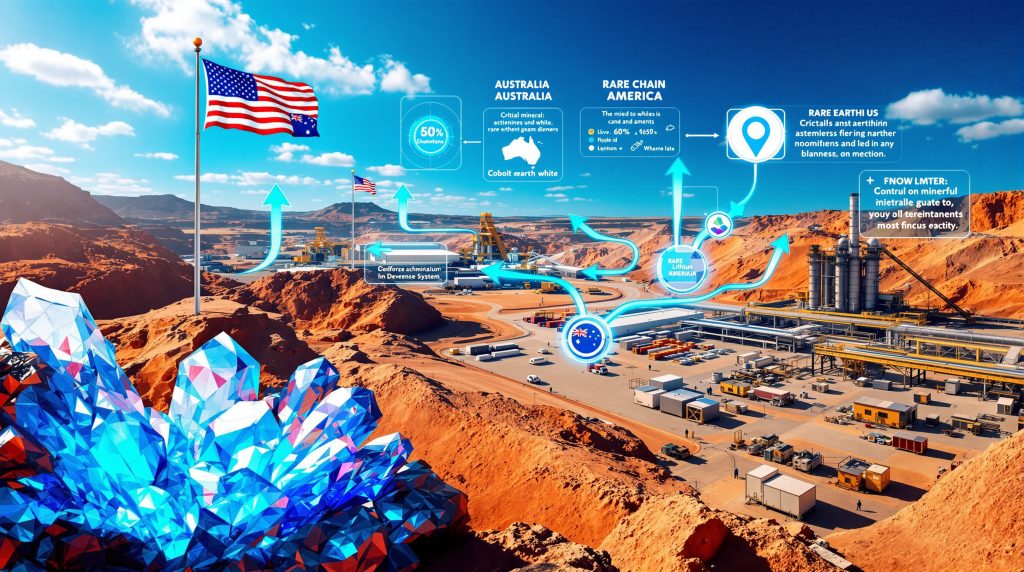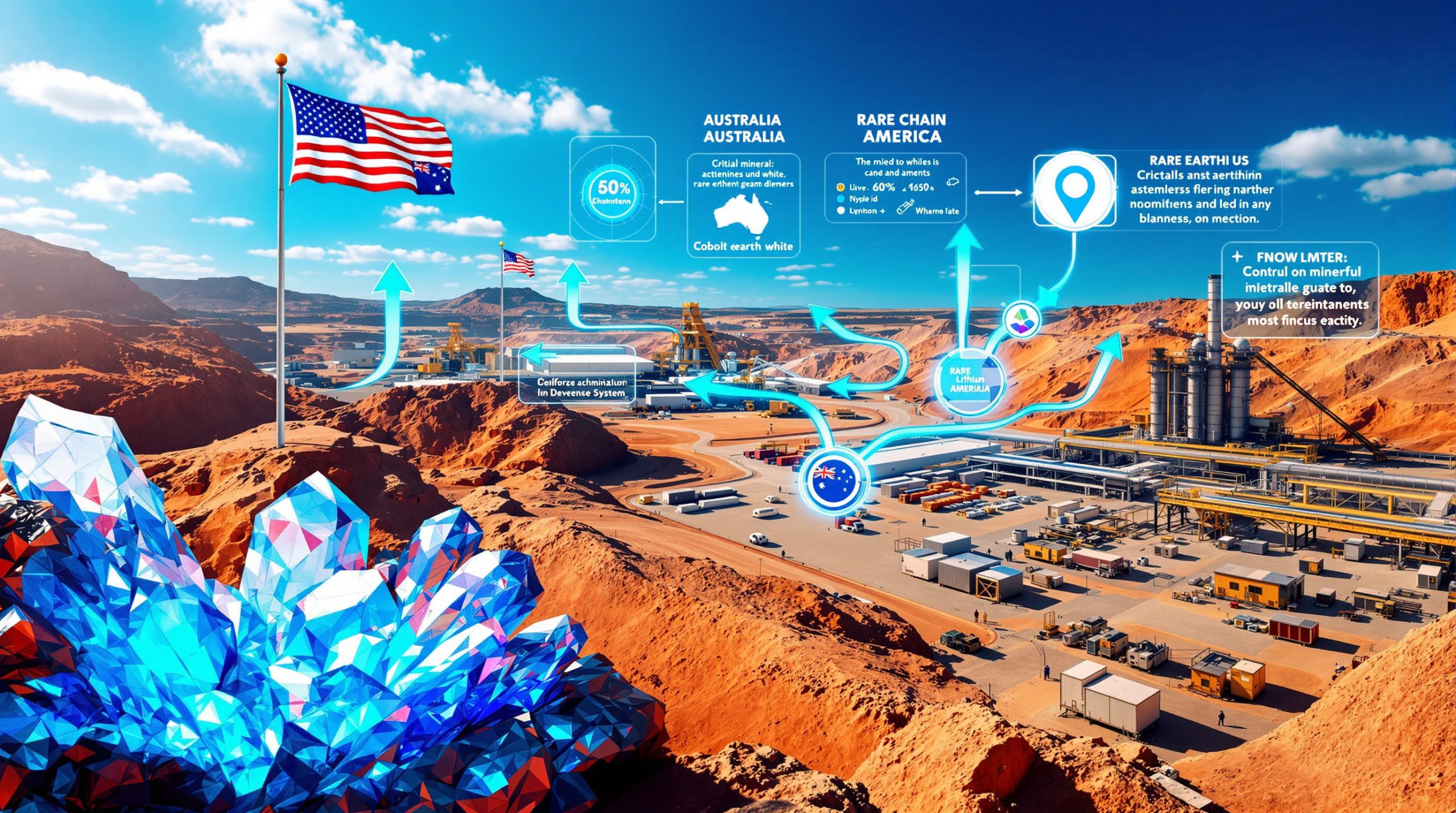US Equity Investments in Australian Critical Minerals: Strategic Partnerships for Supply Chain Security
The United States government has launched a strategic initiative to purchase equity stakes in Australian critical minerals companies, marking a significant shift in how America secures access to resources essential for advanced technologies. This approach represents a deliberate strategy to diversify supply chains away from China and strengthen economic ties with trusted allies.
The Strategic Importance of Critical Minerals
Critical minerals including lithium, cobalt, and rare earths form the backbone of modern technologies, from renewable energy infrastructure to advanced defense systems. Without these materials, the transition to clean energy and development of next-generation technologies would be impossible.
These resources face increasing supply constraints due to growing global demand, particularly as countries accelerate their clean energy transitions. The International Energy Agency estimates that demand for critical minerals and energy security could increase six-fold by 2040, creating unprecedented pressure on supply chains.
Australia possesses approximately 21% of the world's rare earth deposits, 29% of global lithium reserves, and significant cobalt resources, positioning it as a natural partner for US supply chain diversification efforts. The country's stable regulatory environment and strong rule of law further enhance its attractiveness as a strategic resource partner.
China's Market Dominance Creates Urgency
China's dominance in the critical minerals sector extends beyond mining to processing and refining. The country controls approximately 85% of global rare earth processing capacity and dominates production of permanent magnets used in electric vehicles and wind turbines.
Recent export restrictions on gallium, germanium, and specific rare earth products have significantly disrupted global supply chains. These restrictions, implemented in response to various international tensions, highlight the vulnerability of supply chains heavily dependent on a single source.
European and American automotive manufacturers have reported production delays and increased costs due to these supply disruptions. Some manufacturers have been forced to redesign components or seek alternative materials, often at considerable expense and with performance compromises.
What Financial Mechanisms Is the US Offering Australian Companies?
The US government has developed a sophisticated toolkit of financial instruments to secure critical mineral supplies, demonstrating remarkable flexibility in its approach to resource acquisition.
Equity Investment Options
Direct equity purchases represent the most straightforward approach, with the US government acquiring ownership stakes in Australian mining and processing companies. This model provides immediate capital for project development while securing long-term supply access.
"Equity kicker" arrangements combine debt financing with ownership stakes, allowing the US to provide loans while also gaining partial ownership. This approach appeals to companies seeking development capital while maintaining majority control.
Warrant-based structures, similar to those used with Lithium Americas where the US Department of Energy acquired a 5% stake in both the company and its Thacker Pass joint venture with General Motors, offer a particularly innovative approach. These warrants, often structured as "no-cost" instruments, give the US government the right to acquire shares at predetermined prices.
Alternative Funding Pathways
Traditional debt financing remains available for project development, with the US offering loans through various agencies including the Department of Energy and Export-Import Bank. These loans often feature favorable terms compared to commercial alternatives.
Prepayment arrangements allow the US to provide upfront capital in exchange for guaranteed future mineral supplies. This approach gives mining companies immediate funding while securing US access to production outputs.
Offtake agreements commit the US to purchasing specified volumes of production at predetermined prices. These agreements provide revenue certainty for producers while ensuring consistent supply for US manufacturers.
Strategic stockpile purchases enable the US to build reserves of critical minerals through direct market purchases. The Defense Logistics Agency manages these stockpiles, which serve as buffers against supply disruptions.
Case Study: The Lithium Americas Investment Model
The US Department of Energy's acquisition of 5% stakes in both Lithium Americas and its Thacker Pass joint venture with General Motors demonstrates the evolving approach to critical minerals investment.
Rather than direct cash investment, the stakes were acquired through no-cost warrants, a creative financial structure that minimizes immediate government expenditure while securing long-term supply access.
This model has proven particularly attractive for projects requiring significant capital expenditure, as it provides government backing without the political complications of direct ownership. Industry analysts suggest this approach could be applied to numerous Australian projects with similarly strategic assets.
Which Australian Companies Are Positioned to Benefit?
Several Australian critical minerals companies have positioned themselves to capture US investment through strategic project development and active engagement with American officials.
Companies Leading US Engagement
International Graphite has made significant progress with its integrated mine and processing facilities in Western Australia. The company's focus on battery-grade graphite production aligns perfectly with US electric vehicle manufacturing priorities.
Cobalt Blue has developed innovative processing technology for extracting and refining cobalt from pyrite deposits. This approach reduces environmental impacts while producing battery-grade cobalt sulfate suitable for US supply chains.
Several emerging copper producers have gained attention as the metal's importance in electrification becomes more apparent. Industry estimates suggest global copper demand could rise by 50% by 2040, driven primarily by renewable energy and electric vehicle deployment.
Silver-focused companies have also entered discussions, recognizing the metal's critical role in solar panel manufacturing. Each solar panel requires approximately 20 grams of silver, making it essential to renewable energy deployment.
Project Readiness Timeline
US officials have emphasized their focus on projects that can deliver supplies by 2027, creating a clear timeline for company engagement. This preference reflects the urgent need to establish alternative supply chains in response to growing geopolitical tensions.
Companies with projects in advanced development stages have received priority attention during recent discussions. Those with completed feasibility studies, secured permits, and clear paths to production have particular advantages in securing US investment.
Projects capable of rapid integration into existing supply chains receive additional consideration. Companies with established relationships with US manufacturers or experience meeting US technical specifications have demonstrated particular success in engagement efforts.
Geographic Advantages
Western Australian projects benefit from the state's established mining infrastructure, skilled workforce, and supportive regulatory environment. The region's political stability further enhances its attractiveness as a strategic resource partner.
Companies with assets in both Australia and the US have gained additional attention due to their ability to create truly integrated supply chains. These dual-jurisdiction operations offer particular resilience against regional disruptions.
Projects in regions with existing infrastructure, including power, water, and transportation networks, have demonstrated cost advantages that enhance their investment appeal. The reduced capital requirements for such projects make them particularly attractive for government backing.
Why Are Critical Minerals Now Central to National Security?
The elevation of critical minerals to national security status represents a fundamental shift in how governments conceptualize resource security in an increasingly technology-dependent world.
Strategic Equivalence to Traditional Security Assets
Critical minerals are now considered as strategically important as oil or uranium, representing a profound pivot in critical minerals strategy in national security thinking. Defense planners increasingly view resource access as fundamental to military capability maintenance.
This perspective has led to integration of critical minerals into national security frameworks across allied nations, with coordinated approaches to resource security emerging among Five Eyes countries (US, UK, Australia, Canada, and New Zealand).
Many nations now classify specific minerals as "strategic assets" subject to investment protections similar to those applied to defense industries. These protections include enhanced scrutiny of foreign investments and restrictions on ownership transfers.
Defense Applications Driving Urgency
Advanced weapons systems increasingly rely on specific mineral inputs, with rare earth elements particularly crucial for precision guidance systems and night vision equipment. A single F-35 fighter jet contains approximately 417 kg of rare earth elements.
Modern military communication technologies depend heavily on rare earth components for miniaturization and performance optimization. Battlefield radios, satellite communications, and tactical networks all require these specialized materials.
Battlefield electronics, from thermal imaging to drone systems, require secure supply chains to ensure operational readiness. Military planners view reliance on potentially hostile nations for these materials as an unacceptable strategic vulnerability.
Technology Competition Accelerating Demand
Semiconductor manufacturing requires ultra-pure materials including high-purity quartz, gallium, and germanium. As chip production becomes increasingly strategic, securing inputs for these processes has gained national security importance.
Quantum computing developments have increased demand for specific elements including ytterbium, erbium, and dysprosium. These technologies promise to transform cryptography and data processing, with profound implications for national security.
Artificial intelligence infrastructure requires massive computing centers with specialized hardware components dependent on critical minerals. As AI capabilities become central to economic and military advantage, securing these supply chains has gained urgent priority.
How Does This Initiative Connect to Broader US-Australia Relations?
The critical minerals partnership exists within a complex web of diplomatic, defense, and economic relationships between the US and Australia, representing one aspect of an increasingly integrated alliance structure.
AUKUS Connection and Strategic Timing
Critical minerals discussions have occurred alongside AUKUS defense pact review sessions, highlighting the interconnection between resource security and broader defense cooperation. The minerals partnership provides economic substance to the security relationship.
The Australian Prime Minister's upcoming Washington visit on October 20 is expected to include substantive critical minerals discussions alongside defense and trade topics. Industry observers anticipate potential announcements regarding specific investment commitments.
The minerals partnership potentially complements submarine technology transfer agreements, creating a comprehensive approach to alliance cooperation. Australian critical minerals may directly support US naval construction, creating a symbiotic relationship between resource sharing and defense production.
Australia's Strategic Minerals Reserve
Australia has established its own strategic minerals stockpile, designed to buffer against supply disruptions while also serving as a diplomatic asset. The reserve includes lithium, cobalt, and rare earth elements deemed critical to economic security.
Australian officials have expressed willingness to share reserve access with allies including the UK, creating a multilateral approach to resource security. This willingness to share strategic reserves demonstrates the depth of alliance cooperation.
The reserve serves as diplomatic leverage in broader security discussions, allowing Australia to offer tangible contributions to alliance resource security. This approach elevates Australia's strategic importance beyond traditional security contributions.
Multilateral Coordination Efforts
The critical minerals initiative aligns with Quad initiatives involving the US, Australia, India, and Japan, creating a coordinated approach to supply chain resilience across the Indo-Pacific. These efforts include information sharing, technical cooperation, and coordinated mineral investment strategies.
The approach also coordinates with European Union critical minerals strategies, enabling transatlantic cooperation on supply chain security. This coordination reduces duplication while creating more robust alternative supply networks.
There appears to be potential for expansion to include other "friendly" jurisdictions, creating a comprehensive network of resource partnerships. Countries including Canada, Chile, and select African nations have engaged in preliminary discussions about joining this framework.
What Challenges Do Critical Mineral Projects Face?
Despite government support, critical mineral projects continue to face significant obstacles that complicate development timelines and economic viability.
Financing Difficulties
Small market sizes create persistent valuation challenges for critical mineral projects. Unlike gold or copper, many critical minerals lack liquid markets and transparent pricing mechanisms, complicating investment decisions.
Price volatility remains a significant concern, with lithium prices fluctuating by more than 400% over recent years. These dramatic price swings make project economics difficult to predict and increase investment risk.
Limited commercial funding options for early-stage projects create a "valley of death" between exploration and production. Traditional mining finance often gravitates toward established commodities with predictable markets, leaving critical minerals projects struggling to secure development capital.
Market Development Hurdles
Processing capacity gaps in Western nations continue to complicate supply chain development. Despite increased mining activity, refining and processing often remain concentrated in China, creating persistent supply chain vulnerabilities.
Technical challenges in achieving required purity levels have slowed market entry for new producers. Battery and electronics manufacturers require exceptionally high purity levels that can be difficult for new processors to achieve consistently.
Certification and qualification timelines for new suppliers often extend for months or years, delaying revenue generation even after physical production begins. Automotive and electronics manufacturers typically require extensive testing before accepting new material sources.
Environmental and Social Considerations
Increasing ESG requirements for new mining projects have extended development timelines and increased capital costs. While necessary for sustainable development, these requirements can challenge project economics, particularly for smaller companies.
Water usage concerns in drought-prone regions have complicated project development, particularly in Western Australia. New projects must demonstrate responsible water management strategies to secure community and regulatory approval.
Community acceptance challenges for processing facilities have emerged as significant obstacles in some regions. The perception of environmental risks, particularly for rare earth processing which can involve radioactive elements, has led to local opposition to facility development.
How Is Government Backing Transforming the Investment Landscape?
Government involvement is fundamentally changing how markets view critical mineral investments, potentially creating new opportunities for investors across the sector.
Risk Reduction Effects
Government backing significantly derisks project development by reducing financing uncertainty and enhancing market access. Projects with government support demonstrate materially higher completion rates compared to those without such backing.
This support has increased investor confidence in previously marginal projects, expanding the universe of viable resource developments. Projects that might have struggled to attract capital in purely commercial markets have secured funding through blended finance approaches.
The government involvement has enhanced the ability of companies to secure additional private financing on favorable terms. Commercial lenders have demonstrated greater willingness to participate in projects with government backing, viewing the government commitment as validation of project viability.
Valuation Impacts
Market analysts have observed potential premium valuations for companies with government partnerships, with some securing valuations 20-30% higher than comparable projects without such backing. This premium reflects reduced execution risk and enhanced market access.
Increased investor interest in ASX-listed critical minerals companies has been particularly notable, with trading volumes rising significantly following US engagement announcements. Some specialized investment funds have established positions specifically targeting companies with US government connections.
An emerging preference for companies with clear paths to US market integration has shifted capital allocation patterns within the sector. Companies demonstrating established relationships with US agencies or manufacturers have attracted disproportionate investor attention.
Market Structure Evolution
The sector has witnessed growth of public-private partnership models previously uncommon in the mining sector. These models combine government risk mitigation with private sector operational expertise, creating more resilient project structures.
Increasing vertical integration from mine to manufacturing has emerged as companies seek to capture more value and secure market access. Some Australian producers have established processing joint ventures with US manufacturers to create integrated supply chains.
The market has begun developing new financing structures specific to critical minerals, including royalty models, streaming arrangements, and strategic investor partnerships. These innovative approaches help address the unique challenges of critical minerals project development.
What Does This Mean for the Future of Global Mineral Supply Chains?
The US equity investment initiative signals a fundamental restructuring of global mineral supply networks with far-reaching implications for producers, consumers, and geopolitics.
Reshoring and Friendshoring Acceleration
Rapid development of processing capacity outside China has accelerated, with particular focus on Australia, North America, and select European locations. Several billion dollars of investment have been committed to these projects over the past 18 months.
This investment has enabled creation of parallel supply chains for strategic industries, reducing dependency on Chinese processing. The automotive sector has been particularly active in developing these alternative supply chains, driven by both government mandates and commercial risk management.
A clear preference for "friendly jurisdiction" sourcing in government procurement has emerged across Western nations. This preference extends beyond direct government purchases to include contractors and subsidized industries, creating powerful market incentives for supply chain restructuring.
Long-term Market Implications
Premium pricing for non-Chinese material appears likely to persist due to higher production costs and strategic value. Some manufacturers have demonstrated willingness to pay 10-15% premiums for materials from secure supply chains, viewing this as an insurance policy against disruption.
The market has begun developing more transparent pricing mechanisms specific to critical minerals, reducing reliance on opaque Chinese domestic prices. Several price reporting agencies have launched specialized indices for battery minerals and rare earths from Western sources.
Industry participants have discussed potential new commodity exchanges focused on critical minerals, similar to specialized markets for minor metals. These would enhance price discovery and potentially enable hedging instruments for producers and consumers.
Innovation Impacts
The supply chain restructuring has increased investment in recycling and recovery technologies, with particular focus on electric vehicle batteries and consumer electronics. These technologies aim to create circular supply chains less dependent on primary production.
Significant resources have been directed toward development of substitute materials for constrained elements, particularly heavy rare earths. Research programs have explored alternative motor designs, battery chemistries, and semiconductor materials to reduce dependency on the most vulnerable supply chains.
The market disruption has accelerated circular economy approaches for critical minerals, including design for recyclability and materials passporting. These approaches aim to treat end-of-life products as "urban mines" that can supplement primary production.
FAQs About US Investments in Australian Critical Minerals
What specific minerals is the US most interested in securing?
The US is prioritizing lithium, cobalt, rare earth elements, graphite, and manganese—materials essential for clean energy technologies, advanced electronics, and defense applications. These minerals face supply constraints and are currently dominated by Chinese processing capacity. Lithium and rare earth elements have received particular attention due to their importance in electric vehicles and advanced weapons systems.
How does this investment approach differ from traditional mineral procurement?
Rather than simply purchasing minerals on the open market, the US is taking ownership stakes in the companies that produce them, ensuring long-term supply security and influence over production decisions. This represents a shift toward treating minerals as strategic assets rather than commodities. The approach provides developmental capital while creating lasting supply relationships that transcend market fluctuations.
Will these investments affect mineral prices globally?
Government investment is likely to accelerate project development, potentially increasing supply and stabilizing prices over time. However, the creation of parallel supply chains may result in price premiums for materials produced in "friendly" jurisdictions compared to Chinese alternatives. Market analysts anticipate a two-tier pricing system may emerge, with verified responsible supply chains commanding premium prices.
How quickly could new Australian supplies reach the US market?
US officials are focusing on projects that can deliver supplies by 2027, but some advanced projects could begin production earlier. The timeline depends on permitting processes, construction schedules, and the development of necessary processing infrastructure. Early-stage processing may begin as soon as 2025 for the most advanced projects, with full-scale production ramping up through 2028.
What role do private investors play alongside government investment?
Government backing is expected to catalyze private investment by reducing project risks. Many projects will likely use blended financing models combining government support with private capital, potentially creating new investment opportunities in the Australian lithium tax incentives and critical minerals sector. Private investors benefit from reduced development risk while bringing operational expertise and market connections that complement government involvement.
Want to Invest in the Next Major Mineral Discovery?
Stay ahead of the market with Discovery Alert's proprietary Discovery IQ model, which instantly notifies investors of significant ASX mineral discoveries and transforms complex data into actionable insights. Explore why major mineral discoveries can lead to exceptional returns by visiting our dedicated discoveries page and begin your 30-day free trial today.




